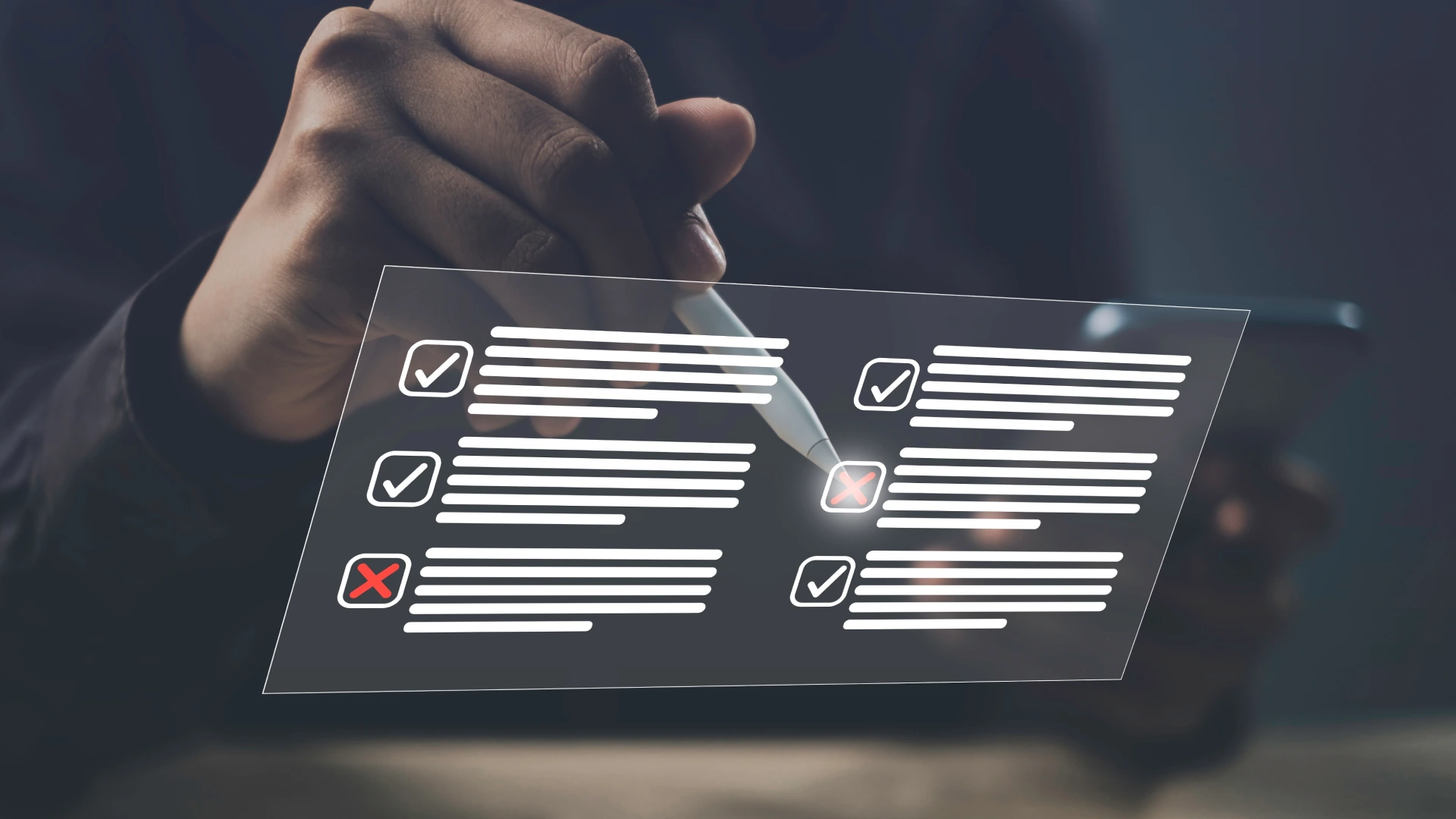Would you stand up in front of your peers and proudly read your website copy aloud? If you just cringed, you’re not alone. Most website copy fails at one of three layers: Surface (it’s confusing), Strategy (it isn’t grounded in reality), or Soul (it sounds robotic). Here’s the framework we use to write copy that converts because it sounds human.
Great website copy does four things fast: signals who it’s for, states a clear value proposition, shows proof, and gives one next step. Use the Connective Copy Diagnosis to find what’s missing: Surface (first-screen skim), Strategy (VOC match rate 35-50% and implied value ratio ≤ 2.0), Soul (a voice only you would write). Write for humans first; optimize after.
The problem with most website copy
Your website copy is failing if visitors can’t answer four questions in 30 seconds: Who is this for? What do you do? Why should I trust you? What should I do next?
But even when copy answers these questions, it often fails deeper tests. It sounds like everyone else in your industry. It makes claims without proof. It uses internal jargon instead of customer language. It optimizes for algorithms instead of humans.
After analyzing hundreds of websites and mining thousands of sales recordings, we’ve identified three layers where copy breaks down. Master all three, and you have copy that converts. Miss even one, and you’re losing customers to competitors who get it right.

The Connective Copy Diagnosis: A three-layer framework
Most companies focus on just one layer. They make it pretty but substanceless. Or strategic but soulless. Or authentic but confusing.
Great copy needs all three.
Surface Layer: Can a first-screen skim tell who it’s for, what you do, why trust you, and what to do next?
This is the 30-second test. Someone lands on your homepage. Can they immediately understand:
- Who this is for (and whether that’s them)
- What you do (in plain English, not jargon)
- Why to trust you (proof, not promises)
- What to do next (clear, singular action)
Your headline carries most of this weight. Which is why we use the Peer Test: Would you proudly read your headline aloud at a networking event? If it makes you cringe or requires explanation, it fails.
Weak Headline (Fails Peer Test): “Synergistic Solutions for Modern Enterprises”
Strong Headline (Passes Peer Test): “Cut dev costs 25% on complex WordPress builds for healthcare IT. No rebuild required.” Subhead: “For in-house marketing teams that need predictable timelines and clean handoffs.” CTA: “Run a copy diagnosis call”
Why this passes: Names audience (healthcare IT), promises outcome (cut dev costs 25%), offers credibility cue (WordPress builds), reduces risk (no rebuild), and gives a clear CTA.
The Headline Formula: Outcome + audience + credibility cue
Example: “Launch accessible WordPress sites 2x faster for in-house marketing teams, without a rebuild.”
Good Surface copy is scannable. It follows well-documented F-patterns that eye-tracking studies reveal. Headers do heavy lifting. First words of paragraphs matter most. Bullets break up walls of text.
But here’s what most miss: Surface isn’t about being clever. It’s about being clear. Your clever tagline that requires three seconds of thought? That’s three seconds when visitors are clicking back to Google.
Strategy Layer: Does the copy mirror customer language and back every claim with near-at-hand proof?
This layer is where copy gets grounded in reality. Two specific metrics tell you if your Strategy layer is solid:
How to measure it:
- VOC match rate: Build a 30-term customer lexicon → scan H1, H2s, first 200 words → matches ÷ 30. Target 35-50%.
- Implied value ratio: Count claims in a section → count proof units (metric, quote, demo, spec, policy, certification) → claims ÷ proof. Target ≤ 2.0.
Worked example: 6 claims, 2 proofs = 3.0 (fail). Add a case metric + client quote → 6 ÷ 4 = 1.5 (pass).
The Copy Correlation Test: 35-50% VOC match rate
VOC (Voice of Customer) match rate measures how much your copy mirrors actual customer language. Not what you think they say. What they actually say.
Here’s how to calculate it: Take your headlines and first 200 words of key pages. Count how many phrases come directly from customer conversations. Divide by total phrases. Aim for 35-50%.


Mining your sales recordings for copy gold
Your best copy already exists. It’s hiding in your sales recordings.
Where do you find this customer language? Your sales recordings are a goldmine. (You are recording sales calls, right? With permission, of course.)
Set up a simple system: After each recorded call, mark timestamps when:
- The energy shifts positively
- They repeat something back to you
- They ask excited follow-up questions
- You nail an explanation
Listen specifically for:
- The exact moment they get excited
- How they describe their problem before you’ve educated them
- What words make them lean in and ask “tell me more”
- The analogies they use naturally
Support tickets are another goldmine. Reviews. Customer emails. Anywhere customers describe their world in their words.
Review these moments monthly. Extract the exact language. This isn’t about copying transcripts. It’s about finding the words that create connection.
Privacy note: Always get permission to record. When using examples, anonymize everything. Industry and role, not company names. Date ranges, not specific dates.
The Implied Value Ratio: ≤2.0
Every claim needs proof. But not eventually. Immediately. Within 150 words.
Count your claims. Count your proof points (specific numbers, customer examples, demonstrations, awards). Divide claims by proof. If your ratio exceeds 2.0, you’re asking for trust you haven’t earned.
Weak Claim (Ratio > 2.0): “We offer the best, fastest, and most reliable support in the industry.” (3 claims, 0 proof)
Strong Claim (Ratio = 1.0): “Our support team resolves 95% of tickets within one hour based on last quarter’s data.” (1 claim, 1 proof point)
Good proof is specific. “We’re fast” is a claim. “Average 48-hour turnaround based on last quarter’s data” is proof. “We’re experts” is a claim. “Our team has 127 combined years in the industry” is proof.
Quick reality check: Building your Evidence Locker takes time. You need to systematically collect metrics, testimonials, case studies, certifications. Most companies don’t do this. That’s exactly why it creates competitive advantage.
Using AI as your Strategy assistant
AI tools like ChatGPT and Claude can accelerate Strategy work. They can analyze 20 competitor sites while you’d still be reading the first one. They can extract patterns from hundreds of reviews. They can identify common language across support tickets.
But here’s the key: AI helps with research and structure. Not final voice. Use it to find patterns, extract language, organize thoughts. Then add your Soul.

Soul Layer: Could only YOU have written this?
This is where copy transcends information and becomes connection. Soul is what makes someone remember you tomorrow. It’s what makes them choose you over someone with identical services.
Soul shows up in three ways:
1. Authentic Voice
Your copy should sound like you at your best. Not corporate you. Not casual you. Professional-but-human you. The you that shows up when you’re explaining what you do to someone you respect at a dinner party.
This means having opinions. Taking stands. Admitting what you’re not good at. If a competitor could have written your sentence, delete it.
Weak Voice (Generic): “We are a leading provider of innovative marketing solutions.”
Strong Voice (Authentic): “We believe most marketing is forgettable. Our job is to create work that your customers will actually remember.”
2. Depth That Rewards
Following our Depth Principle: write for people who genuinely want to understand. This doesn’t mean being verbose. It means including nuance, context, the “why” behind the what.
Surface readers skim your headers. Deep readers get extra value in the paragraphs. Both leave satisfied.
3. Something Unique to Say
What do you believe that your competitors would disagree with? What have you learned that nobody talks about? What honest admission would surprise your industry?
Having something unique to say doesn’t mean being contrarian for sport. It means having genuine insights born from genuine experience.
Opinion → Copy transformation:
Opinion: “Accessibility is part of performance, not an add-on.”
Headline: “Make every release faster and more accessible by default.”
Paragraph: “Teams that bake accessibility into code reviews fix issues once, not three times later. It’s cheaper, kinder to users, and measurably faster to ship.”
Soul-mining prompts to find your authentic voice
If you’re struggling to find your Soul layer, try these exercises:
The Opinion Exercise: List five things you believe that competitors would argue against. Not small things. Core beliefs about how your industry should work.
The Moment of Truth: Document three customer conversations that changed your approach. What did they say that shifted your perspective? How did that change what you do?
The Personality Test: Have three team members independently write three words describing your brand at a dinner party. Compare. The overlap is your authentic voice. The differences show where you need clarity.
These aren’t just exercises. They’re copy foundations. That strong opinion becomes your About page. That moment of truth becomes a case study. Those personality words guide every headline.


The peer test: Your final quality check
Here’s the ultimate test: Would you proudly read your copy aloud to peers at an industry event?
This isn’t about perfection. It’s about authenticity. Copy you’d proudly read aloud has:
- Clarity that doesn’t require explanation
- Claims you can back up if challenged
- A voice that sounds genuinely yours
- Something worth saying
If reading your copy aloud would embarrass you, it’s embarrassing visitors too.
Common copy myths debunked
Myth: “People don’t read online”
Reality: People don’t read boring copy online. They absolutely read copy that speaks to their exact situation in their exact language.
Myth: “Shorter is always better”
Reality: The right length is as long as needed to convert, not one word more. High-consideration purchases need more copy than impulse buys. Your $100K enterprise software needs more explanation than a $10 ebook.
Myth: “SEO keywords matter most”
Reality: Less than 0.63% of users click to page 2 of Google results (Backlinko). But ranking #1 means nothing if your copy doesn’t convert. Write for humans first. Optimize after.
Myth: “Professional means formal”
Reality: Professional means competent, not corporate. The most professional copy is copy that professionally converts visitors into customers. That usually means sounding human.
The CTA formula that works
The CTA Formula: Action + outcome
Examples:
- “Run a copy diagnosis call” (not just “Contact us”)
- “Get your VOC analysis” (not just “Learn more”)
- “Start your copy transformation” (not just “Get started”)
The best CTAs promise a specific outcome, not just a next step. Place your primary CTA after the first proof block and again at the end.
Frequently asked questions
How do you extract VOC (voice of customer) from sales recordings?
Start by marking moments when energy shifts during calls. Transcribe these sections (AI tools can help). Look for patterns in how multiple prospects describe the same problem. Extract exact phrases, especially emotional language and analogies. Build a VOC library organized by topic and use stage.
What’s the ideal proof-to-claim ratio for website copy?
Aim for an implied value ratio of 2.0 or lower. That means no more than two claims per proof point. On crucial pages (pricing, about, key service pages), aim for 1:1. Every claim gets immediate proof within 150 words.
Should I prioritize SEO or human readability?
Always prioritize humans. SEO matters for being found. But if visitors bounce immediately, ranking is worthless. Write for humans first. Then optimize for search without sacrificing readability. Google’s algorithms increasingly reward content that serves human readers anyway.
How do you write headlines that aren’t BS but still convert?
Use the peer test. Would you say this headline to someone’s face? Start with brutal clarity about what you do and for whom. Then add personality through word choice and rhythm, not through vague promises or hype.
Should copy be written before or after design?
Copy and design should evolve together, but copy strategy comes first. You need to know what you’re saying before deciding how it looks. Design amplifies your message. But without a clear message, even beautiful design fails.
When should you hire a copywriter vs DIY with AI tools?
Use AI for research, competitive analysis, and first drafts. Hire a copywriter when you need Soul layer (authentic voice, unique perspective, deep audience understanding). AI excels at Strategy layer tasks. Humans own the Soul layer.
How much copy is too much copy?
There’s no universal answer. High-consideration purchases need more copy. Complex services need more explanation. The test: Does every section move readers closer to action? If yes, it’s not too much. If sections just fill space, cut them.
What role should AI play in copywriting?
AI accelerates research and structure. Use it to analyze competitors, extract patterns from customer data, and create first drafts. But final copy needs human editing for voice, nuance, and soul. AI is your assistant, not your replacement.

Making the framework yours
The Connective Copy Diagnosis isn’t prescriptive. It’s diagnostic. Use it to identify where your copy breaks down:
- Surface problems: People leave confused
- Strategy problems: People don’t believe you
- Soul problems: People don’t remember you
Fix the broken layer first. Then strengthen the others.
Most companies need all three. Start with Surface (because confused visitors don’t stick around to appreciate your Strategy or Soul). Ground it with Strategy (because trust requires proof). Infuse it with Soul (because connection creates customers).
This takes time. Mining sales recordings takes hours. Building your Evidence Locker takes discipline. Finding your authentic voice takes courage.
Most companies won’t do this work. That’s your opportunity.
Ready to write copy you’d proudly read aloud? If you need help mining your sales recordings, building your evidence locker, or finding your authentic voice, let’s talk. We write copy that sounds human because we are.









